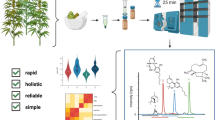Abstract
An HPLC method using electrochemical detection (ED) has been validated for the determination of ADR-529 in plasma and urine using ICRF-192 as an internal standard (IS). Prior to storage and quantitation, both plasma and urine samples require acid stabilization. Acidified plasma samples were prepared for HPLC using a two column solid-phase extraction (SPE). An aliquot of buffered plasma (i.e., pH 6-7) was first deproteinated and desalted on a C-18 SPE column. The analytes were then eluted onto a C-8 SPE column where retention and selective cleanup were achieved in the cation-exchange mode via silanol interactions. Acidified urine samples were diluted in acetonitrile prior to injection. The HPLC system for plasma and urine samples employed two narrow-bore silica columns used in the weak cation-exchange mode and separated by a switching valve. To prohibit late-eluting peaks from passivating the glassy carbon working electrode, a heart-cut containing ADR-529 and the IS was vented from the first silica column to the second using an automated switching valve. Amperometric detection at an oxidation potential of +1050 mV vs a Ag/AgNO3 reference electrode was used. Linearity was validated between 5 and 500 µg/ml in plasma and between 2 and 100 µg/ml in urine. Imprecision and percentage bias were typically <10% for both plasma and urine controls throughout their respective dynamic ranges. The absolute recoveries for ADR-529 and the IS from plasma were >95%. This method is being successfully applied to the pharmacokinetic/dynamic evaluation of ADR-529 in animals and humans.
Similar content being viewed by others
REFERENCES
E. H. Herman and V. J. Ferrans. Pretreatment with ICRF-187 provides long-lasting protection against chronic daunorubicin cardiotoxicity in rabbits. Cancer Chemother. Pharmacol. 16:102–106(1986).
E. H. Herman, V. J. Ferrans, R. S. K. Young, and R. L. Hamlin. Effect of pretreatment with ICRF-187 on the total cumulative dose of doxorubicin tolerated by beagle dogs. Cancer Res. 48:6918–6925 (1988).
J. Sisco. The Physicochemical, Analytical and Pharmacokinetic Properties of the Antineoplastic Agent, ICRF-187, Ph.D. dissertation, Department of Pharmaceutical Chemistry, University of Kansas, August 1989.
D. T. Rossi. Structural elucidation of ADR-529 hydrolysis degradation products. Adria analytical research report 88-9 (1989).
W. Sadee, J. Staroscik, C. Finn, and J. Cohen. (±)-l,2-Bis(3,5-dioxopiperazinyl)propane plasma levels in rats, rabbits, and humans by GLC and mass fragmentography. J. Pharm. Sci. 64(6):998–1001 (1975).
R. Earhart, K. Tutsch, J. Koeller, R. Rodriguez, I. Robins, C. Vogel, H. Davis, and D. Tormey. Pharmacokinetics of (+)-l,2-di(3,5-dioxopiperazin-1-yl)propane intravenous infusions in adult cancer patients. Cancer Res. 42:5255–5261 (1982).
M. Collins, X. Fu, N. Greig, and K. Hellmann. Determination of razoxane by high-performance liquid chromatography. J. Chromatogr. 274:434–440 (1983).
C. Vogel, E. Gorowski, E. Davila, M. Eisenberger, J. Kosinski, R. Agarwal, and N. Savaraj. Phase I clinical trial and pharmacokinetics of weekly ICRF-187 (NSC 169780) infusion in patients with solid tumors. Invest. New Drugs 5:187–198 (1987).
J. R. Baldwin, B. A. Uhrig, and P. K. Narang. Validation of the ultrafiltration assay procedure for the quantitation of ADR-529 in rat plasma. Adria report PK/BAR-3154-89-01 (1989).
B. Bailey. Personal communication.
R. Flanagan and I. Jane. High-performance liquid chromatographic analysis of basic drugs on silica columns using non-aqueous ionic eluents. I. Factors influencing retention, peak shape and detector response. J. Chromatogr. 323:173–189 (1985).
I. Jane, A. McKinnon, and R. Flanagan. High-performance liquid chromatographic analysis of basic drugs on silica columns using non-aqueous ionic eluents. II. Application of UV, fluorescence and electrochemical oxidation detection. J. Chromatogr. 323:191–225 (1985).
R. Flanagan, R. Bhamra, S. Walker, S. Monkman, and D. Holt. Measurement of cardioactive drugs in biological samples by HPLC. J. Liq. Chromatogr. 11(5):1015–1040 (1988).
D. Vendrig, J. Teeuwsen, and J. Holthuis. Determination of vinca alkaloids in plasma and urine using ion-exchange chromatography on silica gel and fluorescence detection. J. Chromatogr. 434:145–155 (1988).
L. Snyder and J. Kirkland. Introduction to Modern Liquid Chromatography, 2nd ed., John Wiley & Sons, New York, 1979, pp. 374–383, 391–398.
M. Thomas and T. Last. Voltammetric electrochemical detection for normal-phase high-performance liquid chromatography. Anal. Chem. 60:2158–2161 (1988).
J. Cooper, E. Hawes, J. Hubbard, G. McKay, and K. Midha. An ultrasensitive method for the measurement of fluphenazine in plasma by high-performance liquid chromatography with coulometric detection. Ther. Drug Monit. 11(3):354–360 (1989).
D. Blevins. Sample preparation involving multimodal bonded phase extraction. Sample Preparation and Isolation Using Bonded Silicas; Proceedings from the Third Annual International Symposium, Analytichem International, 1986, pp. 301–327.
R. Lewis and F. Schwende. HPLC determination of nicorandil in plasma using a double solid phase extraction clean-up. Sample Preparation and Isolation Using Bonded Silicas; Proceedings from the Third Annual International Symposium, Analytichem International, 1986, pp. 197–222.
F. Schwende and R. Lewis. Determination of nicorandil in plasma using high-performance liquid chromatography with photoconductivity and ultraviolet detection; Application to preclinical pharmacokinetics in beagle dogs. J. Chromatogr. 525:151–160 (1990).
D. Lakings, J. Friis, and M. Bruns. High-performance liquid chromatographic method for the determination of eclanamine and its N-desmethyl and N,N-didesmethyl metabolites in urine. J. Chromatogr. 428:131–139 (1988).
R. Kupferschmidt and R. Schmid. Specific routine determination of 3′-azido-3′-deoxythymidine (AZT) in plasma by partly automated liquid chromatography. Clin. Chem. 35(7): 1313–1317 (1989).
J. Cox and R. Pullen. Isomodal column switching high-performance liquid chromatographic technique for the analysis of ciglitazone and its metabolites in human serum. J. Chromatogr. 307:155–171 (1984).
Author information
Authors and Affiliations
Rights and permissions
About this article
Cite this article
Lewis, R.C., Phillips, B.A., Baldwin, J.R. et al. A Sensitive and Specific Procedure for Quantitation of ADR-529 in Biological Fluids by High-Performance Liquid Chromatography (HPLC) with Column Switching and Amperometric Detection. Pharm Res 9, 101–108 (1992). https://doi.org/10.1023/A:1018992029844
Issue Date:
DOI: https://doi.org/10.1023/A:1018992029844




